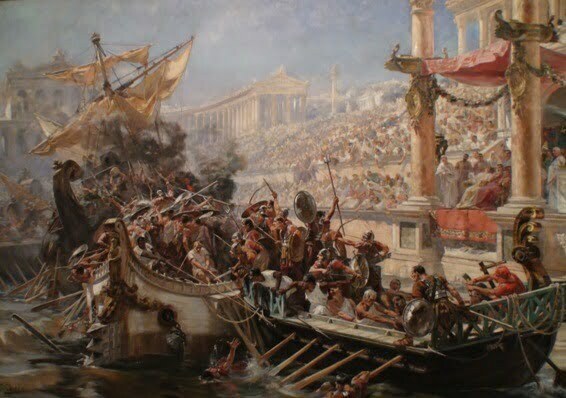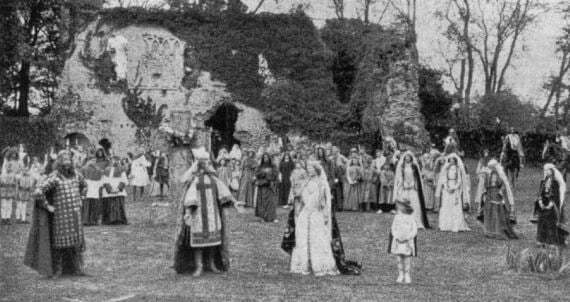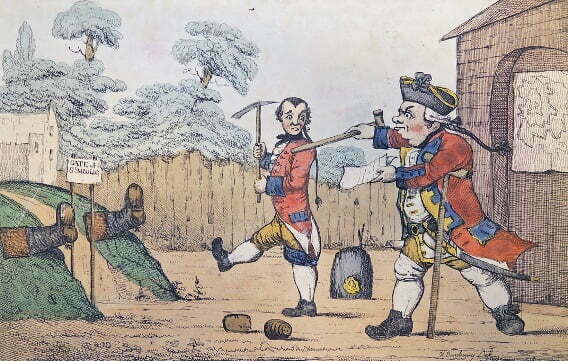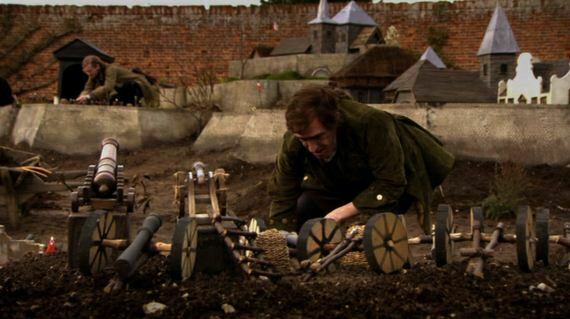
Lately I have been seeing something of English Civil War re-enactments. I have absolutely no interest in dressing up in seventeenth-century clothes, bearing a musket, or shouting my allegiance to Charles or Cromwell, but it is fascinating to see those who do. Most recently I witnessed members of the English Civil War Society (ECWS) in London, marching in de rigeur regalia down the Mall and on the Horse Guards Parade to mark the anniversary of the execution of King Charles I. Their King;s Army being a royalist regiment (the ECWS also incorporates the Roundhead Association), it is a solemn occasion, accompanied by speeches and an oration from a cleric, unfortunately inaudible to the late January crowd gathered in the distance. A group of them proceeded to Banqueting House, in Whitehall, outside which the king was executed, following, as a severe re-enactor announces, “a sham trial, when fifty-nine of blood backed by a military junta, who had seized power, condemned his majesty illegally to a vile and horrid murder“. These people mean business.
Less obviously partisan, and rather more fun for a crowd, was the re-enactment last summer of a battle between Royalists (Cavaliers) and Parliamentarians (Roundheads) at Chippenham, approximately recreating events in the town during the summer of 1643. A large crowd arranged around the perimeter of a sloping green saw the two armies undertake assorted manouevres in accordance with contemporary military tactics, with the few wounded or dead patiently lying on the ground until it was time to get up again and take part in the next piece of action. Muskets fired, cannon roared, cavalry charged (at a gentle pace) and the action was described for us over a public address system by an enthusiastic commentator, who did their best to make the outcome seem in doubt, when history had already told us that the Royalists were the victors. It was genteel, mildly instructive (so that’s how you hold a pike), and did hold up some distant mirror to our history.

Those participating in these re-enactments are ordinary people with equal passions for history and theatre. They dress in contemporary fashion, taking pride in the absence of any inauthenticity. The clothes are as they would have been, modern glasses are frowned upon (those needing to wear something to see have glasses made such as were available in the 1640s). Mobile phones must be hidden. Inclusiveness overrides historical specificity when it comes to the actors themselves, who include a fair number of women, and in the regiment that I was watching two or three British Asians. History, you understand, is something to be found in the heart.
There is an unevenness to the people and proceedings which has an authenticity of its own. The actors are of all shapes, ages and abilities. Though most are rather older than they who would have done the fighting at the time, they look like the plain people of the times, called to arms from their fields and homes through a mixture of enthusiasm and inevitability. They are divided into regiments, with leaders to whom they show allegiance and from whom they receive the battle plan that they must follow. The Civil War armies were filled with such people, the cannon fodder armed with whatever came to hand, while the elite troops were kept back for key engagements. This is how wars are conducted. We’re seeing it today in Ukraine.
Those taking part show such pride in what the represent and what they know. Talk to any of them and you get a detailed account of how they are dressed and armed, how what was happening around them came to be, how verifiably historical it all is. It may not be good (i.e. academic) history, it may be simplistic, placing fact over complexity, but that it informs to any degree has historical value. In any case, what they are really showing is not so much what happened as a faith in what happened. The excitement of pretend is what no conventional written history can ever supply, and we love to pretend.
There are many such groups, in this country and other lands. They re-enact scenes from conflicts to ordinary lives, from the ancient world to the (fairly) modern. Groups in the UK include the ECWS and its Civil War rival The Sealed Knot, The Hoplites (Ancient Greek warfare), the Swords of Penda (medieval lives), the Medieval Siege Society, the Napoleonic Association, the Bluejackets (Victorian era Royal Navy) and the Re-Enacting Ancient Times Society (multi-period), many of them being members of a National Association of Re-enactment Societies.

What is the reason behind this passion for re-enactment? Battles have probably been re-enacted ever since there were battles. The Romans put on lavish recreations of victories in their amphitheatres, even to the extent of flooding arenas to depict naval engagements, a form of entertainment known as a naumachia. In this country there have been recreations of battles put on as celebratory entertainments from the seventeenth century at least. King Charles II, in 1674, had the siege of Maastricht (1673) recreated near Windsor Castle, with 700 soldiers taking part. An entertaining Wikipedia page on Historical reenactments lists many of these extravaganzas. But such theatrical triumphs were propaganda. Their way of thinking persist to our times in parades and flyovers. Those recreated by ordinary people are something else. They must tap in a deep need for identification, and a compulsion for imitation. Their goal is not propaganda; it is catharsis.
The roots of this may lie in medieval mystery play cycles. Towns would recreate stories from the Bible, with different stages depicted on pageant carts that would process through the streets. Local tradespeople could take part through the guilds to which they belonged. It was history and actuality, for a society wholly determined by the religion all were expected to follow, and largely amateur. Importantly, it was the people’s history, even if written and carefully steered by clerics. Historians of theatre tell us that such pageants evolved into the Morality plays, which in turn profoundly shaped Renaissance theatre. But at that point performance is professionalised, and the people are only the audience.
Histories of re-enactments tend to point to the Eglinton Tournament of 1839, a lavish and costly recreation of a medieval tournament, as starting the craze for re-enactments, but it was produced at the whim of Lord Eglinton at his Ayrshire and was an aristocratic affair, performed by an elite, even if members of the 100,000 audience were invited to wear medieval dress if they could. Nevertheless it was not true participatory theatre.

A stronger candidate for a founder of modern amateur recreations of past events, if not military ones as such, is Louis N. Parker (1852-1944). Parker was a dramatist and composer with a taste for historical subjects. He combined his expertise with his passions in creating huge pageants in which hundreds of the people of a town re-enacted scenes from its past. The first of these, the Sherborne Pageant, in Dorset, was presented in 1905; the massively successful Warwick Pageant followed in 1906. Held in the grounds of Warwick Castle and marking the ‘Thousandth Anniversary of the Conquest of Mercia by Queen Ethelfleda’, it featured 2,000 performers and took place over a whole week before a total audince of 44,000. Characters portrayed in the pageant including Caradoc, Cymbeline, Piers Gaveston, Queen Elizabeth, William Shakespeare (as a boy), and of course Queen Ethelfleda. Both Sherborne and Warwick were filmed by the Charles Urban Trading Company.
A craze for pageants was begun through the success of these naive but spectacular and sincere productions. They presented history as a succession of incidents and triumphs, but what was most important about them was that the majority of the performers were the residents themselves. They were telling their own history; they were their own history.

Cinema, and then television, would take over the sentimental presentation of history from the theatre and public pageants. For many years films romanticised the depiction of history according to the tastes of Hollywood producers, but with the growth of independent filmmaking in the 1960s their was a growing call for historical authenticity. As I have noted in a previous post, historians started to be employed by filmmakers to give a mark of credibility to their work (even if what historians advised and what ended up on the screen often differed greatly), with greater attention given to costume, language, character and place. Andrew Mollo, a military uniforms specialist who worked on Kevin Brownlow’s It Happened Here (UK 1964) was among this new breed. It may not be coincidental that it was around this time that the first of the modern re-enactment societies appeared in the UK – The Sealed Knot was founded in 1968. Evidence-based knowledge and the aspiration towards dramatised authenticity came together.
Modern films have done so much to supplant the public thirst for recreated, visualised history, but on occasion they too have an amateur, participatory element. Crowdfunding initiatives for low budget films have included rewarding funders by letting them appear as extras. Chasing the Deer, a 1994 British film on the Jacobite Rebellion, is an example with a military theme (though for the battle scenes a re-enactment group was used, the Scottish Clan Battle Society).

There is another antecedent, which comes out of a complementary history of toy soldiers and war games. Both are as old as can be imagined, and both are chiefly amateur and participatory – you need to have a friend to play with who can be your enemy. One instance of the latter has particular value in analysing the passion for re-enactment, and it is to be found in Laurence Sterne’s novel The Life and Opinions of Tristram Shandy, Gentleman (1759-1767).
In this great novel where digression matters more than narrative direction, a key digression is the passion of Toby Shandy (the narrator’s uncle) for recreating the battles in which he has fought. Toby is the gentlest of characters, but he knows war in all its bloodiness. He took part in the Siege of Namur (1695), fighting on the side of the Grand Alliance (Dutch Republic, Holy Roman Empire and England) against the French in the Nine Years’ War. During the siege Toby received an injury to the groin, the details of which are not made clear but were clearly traumatic. He repeatedly goes over the narrative in his later years, firstly by trying to use maps, then by building a model of the battlefield on his bowling green, with the help of his loyal retainer Corporal Trim.
Toby is embarrassed by his injury as he is embarrassed by any reference to sex. There is a discussion between male characters on the details of Tristram’s impending birth (much of the book takes place before the birth of the person whose life it is ostensibly trying to document). Toby changes the subject when the details become too much for him, with this wildly incongruous yet somehow euphemistic line:
I wish, quoth my uncle Toby, you had seen what prodigious armies we had in Flanders!
His every thought takes him back to the battlefield which he lays out on the green as though setting out his mind. Sterne (in the guise of Tristram) describes this passion as being Toby’s HOBBY-HORSE (usually capitalised in the book), or hobby to you and I. Sterne is drawn to those things which actually occupy people’s minds, as opposed to what correct form might expect them to be thinking:
Nay, if you come to that, Sir, have not the wisest of men in all ages, not excepting Solomon himself,—have they not had their HOBBY-HORSES;—their running horses,—their coins and their cockle-shells, their drums and their trumpets, their fiddles, their pallets,—their maggots and their butterflies?—and so long as a man rides his HOBBY-HORSE peaceably and quietly along the King’s highway, and neither compels you or me to get up behind him,—pray, Sir, what have either you or I to do with it?
However, there is more to his sympathy than simply saying that if such obsessions do no harm then there is no need to worry about them. For Sterne, such passions not only occupy a mind but define it:
A man and his HOBBY-HORSE, tho’ I cannot say that they act and re-act exactly after the same manner in which the soul and body do upon each other: Yet doubtless there is a communication between them of some kind; and my opinion rather is, that there is something in it more of the manner of electrified bodies,—and that, by means of the heated parts of the rider, which come immediately into contact with the back of the HOBBY-HORSE,—by long journies and much friction, it so happens, that the body of the rider is at length fill’d as full of HOBBY-HORSICAL matter as it can hold;—so that if you are able to give but a clear description of the nature of the one, you may form a pretty exact notion of the genius and character of the other.
Toby’s HOBBY-HORSE is a map of his mind. To avoid being continually asked about his wound, he sets out the elements of his trauma on the bowling green, with rivulets, ravelins, cuvettes, counterscarps and other such military minutiae. Ostensibly it is make things clearer for questioners, but Toby’s HOBBY-HORSE, for all its detail, never leads the enquirer to source of his pain. This is exemplified by the novel’s famous comic scene, rich in the double entendres that Sterne loved so, when the Widow Wadman tries to find out whether Toby is adequately equipped for marriage, and Toby says he can show her the very spot, meaning on his map of Namur:
You shall lay your finger upon the place—said my uncle Toby.——I will not touch it, however, quoth Mrs. Wadman to herself.
Toby’s HOBBY_HORSE not only provides cover for his sexual fears, but masks the realities of warfare as well. As film critic and Shandean David Thomson notes in his book Wild Excursions:
Uncle Toby and Trim are not just survivors but emotional refugees from the army, oblivious of its imperfections and so loyal to the dream of its romance that they believe some insurmountable necessity in their own nature made them soldiers.
Play protects one from reality. This is the child’s response to the threatening world: playing out its stories, finding comfort in repetition, gaining mastery of the imaginary world until they are ready to face the real one. It is Sterne’s genius to have understood this as an adult need as well. Without his HOBBY-HORSE, Uncle Toby would be wounded indeed.

These themes somehow come together in A Cock and Bull Story (2005), Michael Winterbottom’s irregular film of the supposedly ‘unfilmable’ Tristram Shandy. Steve Coogan plays Tristram, his father Walter, and Coogan himself, and Rob Brydon plays Toby and himself. The film attempts to mimic the novel by showing both story and a commentary on its construction. It shifts between the eighteenth century and the twenty-first, interweaving parts of the story and the film in production.
There are scenes of the siege of Namur, where we see Toby receiving his injury, and the recreation of Namur at the Shandy home. But the filmmakers find the battle scenes to be unsatisfactory. Ingoldsby, played by Mark Williams, belongs to a re-enactment society, which he promises can produce an authentic display of seventeenth-century warfare. Ingoldsby is an enthusiastic pedant, criticising filmed battles scenes that others admire for their anachronistic details, suggesting that every re-enactor has the name of a soldier from the period, wedded to fact-based authenticity. It is a none too kindly mockery of the re-enactor stereotype, but it does fit well enough with the trouble the film confesses it has at reproducing that which is genuine.
We see the re-enactors practising, though they are never filmed. But the battle scenes at the start of the film do exist, and they feature genuine re-enactors, from the Sealed Knot. They are the real thing at last. Meanwhile, Toby and Trim build their battlefield in the garden and Toby leads Widow Wadman (played by Gillian Anderson) to the very spot where he received his wound (just beyond the asparagus bush).

The film replays the novel in an attempt to reproduce it, knowing that it can never do so successfully. It can re-enact, but it can never lead you to the right place. Instead it is the replaying, the imitation, the retakes, that matter. That is what we need to protect ourselves. The guns were never loaded, Toby’s wound never happened, the battlefield dead can rise up to fight again. With such knowledge, we can stay safe.
Links:
- The National Association of Re-enactment Societies site links to many re-enactment socities (but certainly not all of them)
- There is detailed information on historical pageants on the The Redress of the Past: Historical Pageants in Britain site
- There is free-to-view film of the 1906 Warwick Pageant on the BFI Player
- There is a prodigious army of books about Tristram Shandy. David Thomson’s Wild Excursions: The Life and Fiction of Laurence Sterne (1972) is very fine, if you can track down a copy
- I’ve not read it, but Simon During’s essay ‘Mimic toil: Eighteenth-century preconditions for the modern historical reenactment‘ in Rethinking History: The Journal of Theory and Practice, Volume 11, 2007 – Issue 3: Reenactment, looks at some of these matters, including Tristram Shandy, in depth, as part of a special issue on re-enactments. See also this conference programme on the Institute for the Public Understanding of the Past conference entitled Once More with Feeling: International Conference on Re-enactment, organised with the Laurence Sterne Trust at Shandy Hall, in Coxwold, North Yorkshire in 2008
- My 2018 blog post Film and the Historian, inspired by Mike Leigh’s film Peterloo, looks as historical authenticity and cinema